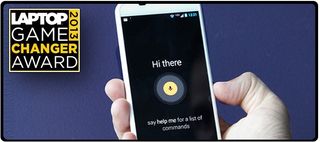Motorola Moto X - Game Changer Award Winner 2013

In a year in which big-screen, quad-core phablets became mainstream, the Moto X went against the grain — and not just because you can customize this Android phone online with a wood finish. The first Motorola handset to launch under Google's wing, the Moto X favors brains over brawn and actually listens and reacts to what its users have to say. And you don't even have to press a button.
Want to make a call while you're driving? Just say "OK, Google Now" to the Moto X, and tell it whom you want to dial and whether it's their home or mobile number. The Moto X takes care of the rest. The same thing goes for playing your favorite music, looking up directions or weather, or posting to Twitter. Motorola calls this feature touchless voice control, but an easier way to describe it is Siri, without the work.
"There are lots of services in the cloud today where you can get the phone to respond to your voice and do things," said Andrew Wells, senior director of engineering at Motorola Mobility. "We felt that, if we found a way to get into that mode in a more natural way, we'd be able to create a very new and unique way of interacting with your device."
Credit Motorola's new X8 Mobile Computing System for this breakthrough, which includes a dedicated natural language processor. This is what allows the Moto X to always be waiting for you to say those magic words ("OK, Google Now") without draining your battery.

Motorola also leveraged its audio expertise to enable the Moto X's voice recognition to work in a variety of conditions. During our review of the phone, we sat several feet away from the Moto X at a crowded conference-room table, and the device still recognized our — and only our — voice.
"We spent a lot of time with our audio engineering team, which developed special noise-reduction algorithms that allow us to filter out background noise and focus on looking for the actual trigger itself," said Wells. [This] obviously helps us in getting good accuracy while you're in the car or the room where other people are speaking.”
MORE: Motorola 2013 Rating—Best and Worst Smartphone Brands
Stay in the know with Laptop Mag
Get our in-depth reviews, helpful tips, great deals, and the biggest news stories delivered to your inbox.
One could argue that Google itself is stealing some of the Moto X's thunder with its new Nexus 5 phone and KitKat operating system. Once you say "OK, Google," you can perform lots of the same queries on the Nexus 5 as you can on Motorola's flagship. But there are some important differences between the devices. The Nexus 5 experience isn't touchless, because you need to press the power button and make sure you're on the home screen. In other words, it's not always on.
Based on what Motorola has observed thus far, many Moto X users have simply stopped using the dialer to make calls and the address book to look up contacts. They're also using the touchless voice control to perform very specific searches that would otherwise take too long to type, such as "Find me great restaurants within five blocks of where I am right now."
In the not-too-distant future, voice control could extend to changing hardware settings, such as toggling Wi-Fi or Bluetooth, or maybe even to more complex tasks, like enhancing photos. "Certainly, the platform that Google has put together for their voice search would be able to do things like that at some point in the future," Wells predicted.
If you're thinking that touchless voice control has a lot of potential beyond smartphones, you're not alone. We asked Wells if the touchless voice control could wind up in something like a smartwatch or Google Glass, and he was keen to point out that the voice capabilities in Google's heads-up display are also inferior to Motorola's innovation because you have to press a button before you say the "OK, Glass" command.
"In time, as Motorola looks at different types of products, I would expect us to also be looking for ways to integrate this technology," Wells hinted. "This has huge potential."
Game Changer Award Winners 2013
CAMERA: Nokia Lumia 1020
The Lumia 1020 packs a 41-megapixel sensor and lets you zoom in on photos after you take them.
TABLET: Amazon Kindle Fire HDX
Amazon has reinvented tech support with the Mayday button on its new tablet.
GAMING: Oculus Rift
This jaw-dropping virtual reality gaming headset literally puts you inside the action.
WEARABLE TECH: Google Glass
A wearable breakthrough, Glass lets you snap pictures, get directions, speak to text and a whole lot more.
PC PERIPHERAL: Leap Motion
Leap Motion can read your hand gestures for doing everything from gaming to exploring the universe.
CARRIER: T-Mobile
T-Mobile has shaken up the wireless world by nixing contracts and making phone upgrading easy.
SMARTWATCH: Pebble
Pebble is taking smartwatches mainstream with an e-paper display, useful apps and a low price.
APP: Vine
Vine is a whole new way to communicate and tell stories via 6-second videos that are a cinch to share.
ENABLING TECHNOLOGY: Intel Bay Trail
Intel's powerful but efficient new CPU gives 2-in-1 tablets and laptops more speed and battery life.
